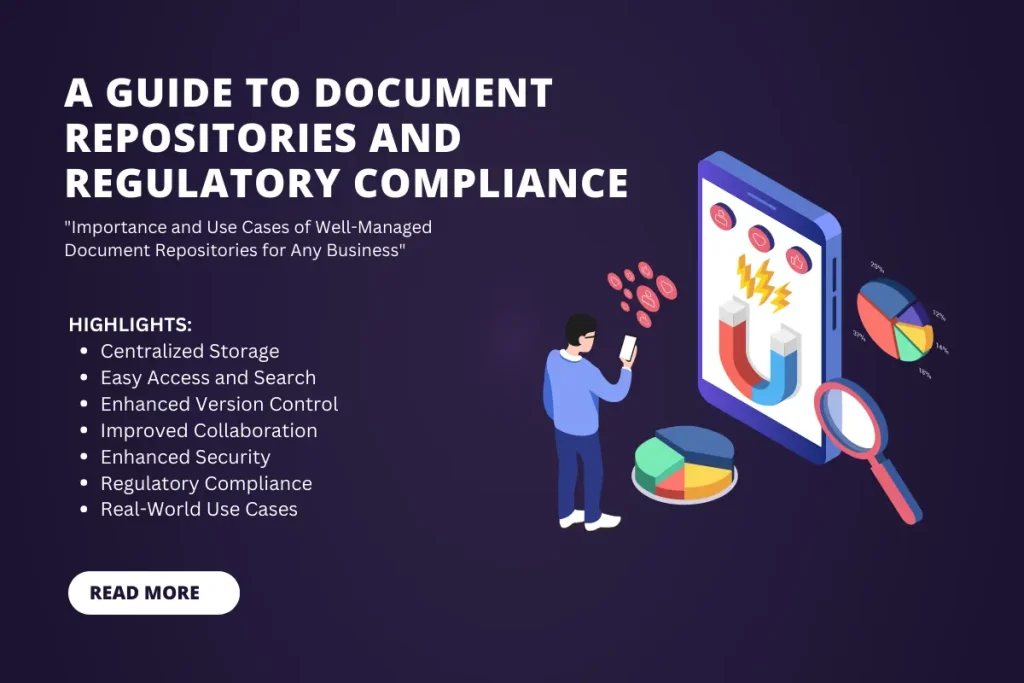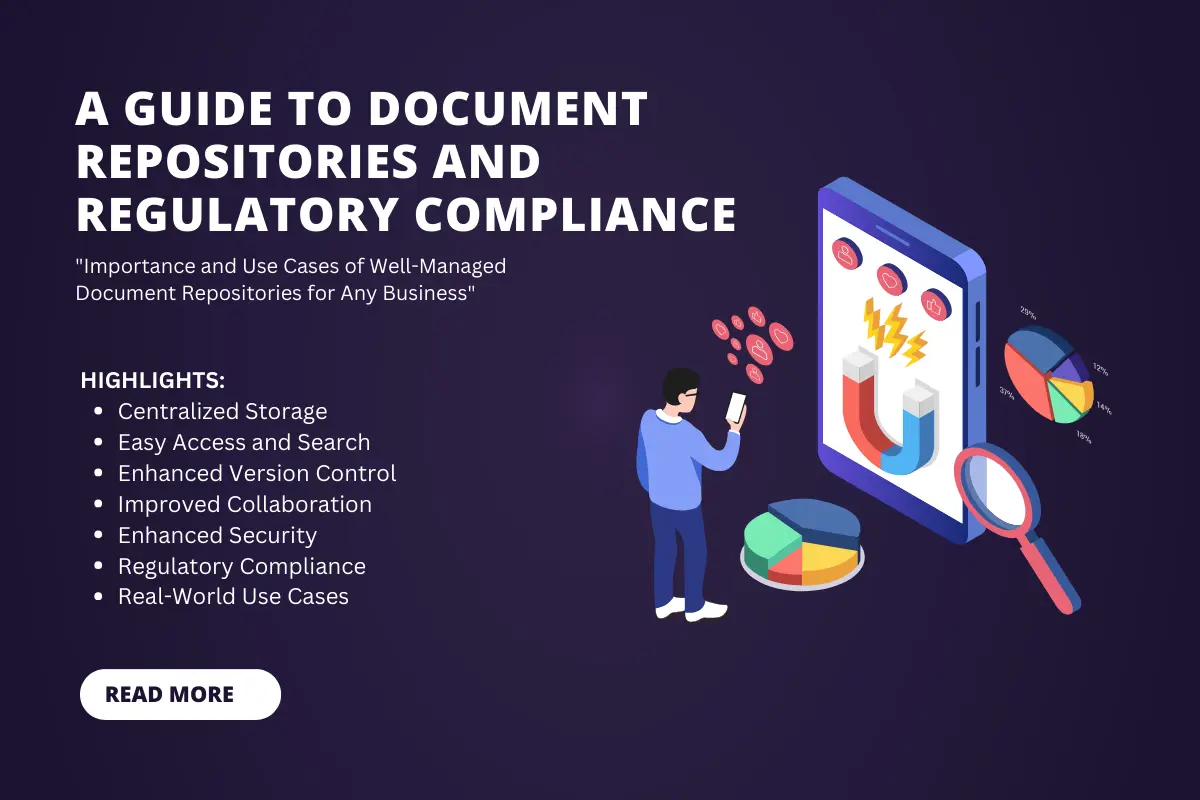The Role of Managed Documents in Regulatory requirements
No. | Heading | Subheading |
|---|---|---|
1 | Introduction managed documents with regulatory requirements | |
2 | Why a Document Repository Matters | – Centralized Storage, – Easy Access and Search, – Enhanced Version Control, – Improved Collaboration, – Enhanced Security, – Reduced Costs, – Regulatory Compliance |
3 | Real-World Use Cases of Document Repositories | – Finance, – Human Resources, – Legal, – Sales & Marketing, – Manufacturing |
4 | Choosing the Right Document Repository | – Scalability, – Security, – Integration, – Ease of Use, – Cost |
5 | Popular Document Repository Solutions (as of May 2024) | |
6 | Additional Considerations | – Document Classification, – User Training, – Retention Policies |
7 | Regulatory Requirements for Document Retention | – Common Federal Regulations (US), – Internal Revenue Service (IRS), – Securities and Exchange Commission (SEC), – Health Insurance Portability and Accountability Act (HIPAA), – Sarbanes-Oxley Act (SOX), – Fair Labor Standards Act (FLSA), – Beyond Federal Regulations |
8 | Consequences of Non-Compliance | – Fines, – Legal Action, – Reputational Damage, – Operational Challenges |
9 | Best Practices for Maintaining Past Year’s Document Repositories | – Develop a Document Retention Policy, – Automate Retention Schedules, – Regular Reviews and Audits, – Disaster Recovery Plan, – Employee Training |
10 | Leveraging Technology for Effective Retention | – Retention Rules and Policies, – Audit Trails and Version Control, – Retention Reporting, – Retention Workflow Automation |
11 | The Future of Document Repositories: Emerging Trends and Considerations | – Artificial Intelligence (AI) and Machine Learning (ML), – Advanced Security Features, – Cloud-Based Solutions, – Integration with Business Applications, – Focus on User Experience (UX), – Data Privacy Regulations, – The Rise of Big Data, – The Evolving Regulatory Landscape |
12 | In Conclusion |
# Introduction
In today’s digital age, businesses generate a staggering amount of documents. From contracts and invoices to
marketing materials and employee records, managed documents regulatory requirements keeping track of everything can be a nightmare. This is where a
well-managed document repository (DR) comes in. It’s more than just a digital filing cabinet; it’s a central
hub that streamlines document management, boosts efficiency, and ensures regulatory compliance..
1. Why a Document Repository Matters
A disorganized document system leads to wasted time and lost productivity. Imagine employees scrambling to
find
crucial contracts or facing delays because they can’t locate a specific invoice. A Document Repository (DR)
eliminates this chaos by offering several key benefits:
- 1.1 Centralized Storage: Say goodbye to scattered documents across individual
computers,
shared drives, and email attachments. A DR provides a single, secure location for all your
business-critical
documents, ensuring easy access and management. - 1.2 Easy Access and Search: Gone are the days of digging through endless folders.
Modern
DRs offer powerful search functionalities, allowing users to find documents instantly using keywords,
dates,
or even document types. - 1.3 Enhanced Version Control: No more confusion about which version of a document is
the
latest. A DR tracks changes and versions, ensuring everyone works with the most up-to-date information. - 1.4 Improved Collaboration: Documents are no longer siloed. Team members can access,
share, managed documents regulatory requirements
and collaborate on documents in real-time, fostering better communication and project management. - 1.5 Enhanced Security: A DR provides robust security features like access control,
encryption, and audit trails. This ensures that only authorized personnel can access sensitive documents
and
protects your data from unauthorized access or breaches. - 1.6 Reduced Costs: A DR can save your business money by minimizing paper usage, storage
costs, and the time wasted searching for misplaced documents. - 1.7 Regulatory Compliance: Many industries face strict regulations regarding document
retention and accessibility. A DR helps ensure you meet these requirements by keeping documents
organized,
readily retrievable, and tamper-proof.

2. Real-World Use Cases of Document Repositories
Document Repositories (DRs) are valuable for businesses of all sizes and across various industries. Here are
some managed documents regulatory requirements
specific examples of how they can be used:
- 2.1 Finance: Streamline accounts payable and receivable processes by storing invoices,
receipts, and financial statements in a centralized location. - 2.2 Human Resources: Manage employee onboarding, performance reviews, and disciplinary
records electronically in a secure and easily accessible repository. - 2.3 Legal: Securely store contracts, legal documents, and intellectual property within
a DR
to ensure easy access and retrieval for legal matters. - 2.4 Sales & Marketing: Keep track of marketing materials, sales proposals, and customer
interaction records for a holistic view of customer engagement. - 2.5 Manufacturing: Maintain quality control documents, production schedules, and
product
specifications in a central location for efficient production processes.
These are just a few examples. The possibilities are endless, as any business with a document trail can
benefit managed documents regulatory requirements
from a well-implemented DR solution.
3. Choosing the Right Document Repository
With a plethora of DR solutions available, choosing the right one for your business needs is crucial. Here
are
some key factors to consider:
- 3.1 Scalability: Can the DR accommodate your current document volume and grow with your
business needs? - 3.2 Security: Does the DR offer robust security features like encryption, access
control,
and audit trails? - 3.3 Integration: Can the DR integrate with your existing business applications like
CRM,
ERP, or HRIS for seamless data flow? - 3.4 Ease of Use: Is the DR user-friendly and intuitive, allowing your employees to
navigate
and utilize the system effectively? - 3.5 Cost: Consider the pricing model (subscription, perpetual license) and ongoing
maintenance costs.
4. Popular Document Repository Solutions (as of May 2024)
- 4.1 Microsoft SharePoint Online
- 4.2 Google Drive Enterprise
- 4.3 Dropbox Business
- 4.4 Box
- 4.5 OpenText Documentum
5. Additional Considerations
- 5.1 Document Classification: Develop a clear document classification system to
categorize
documents efficiently within the DR. - 5.2 User Training: Provide proper training to your employees on using the DR system
effectively. - 5.3 Retention Policies: Establish clear document retention policies that comply with
industry regulations and your business needs.
6. Regulatory Requirements for Document Retention
The importance of maintaining past year’s document repositories goes beyond just organization. Businesses are
subject to managed documents regulatory requirements various regulations that mandate document retention for specific periods. These regulations vary
depending on your industry and location.
Here are some of the common federal regulations in the US that require document retention:
- 6.1 Internal Revenue Service (IRS): Businesses must typically retain tax records for a
minimum of three years after filing a tax return. - 6.2 Securities and Exchange Commission (SEC): Publicly traded companies face stricter
regulations and may need to retain financial records for longer periods. - 6.3 Health Insurance Portability and Accountability Act (HIPAA): Healthcare providers
and
organizations must retain patient medical records for at least six years. - 6.4 Sarbanes-Oxley Act (SOX): Publicly traded companies and their subsidiaries must
retain
financial records and internal controls documentation for at least five years. - 6.5 Fair Labor Standards Act (FLSA): Businesses must retain payroll records for at
least
three years from the last related payment.
Beyond Federal Regulations:
In addition to federal regulations, several state-specific laws and industry regulations may mandate document
retention. It’s crucial to research the specific regulations applicable to your business and ensure
compliance.
Consequences of Non-Compliance:
Failing to comply with document retention regulations can result in severe consequences for your business.
These
include:
- 6.6 Fines: Regulatory bodies can impose significant financial penalties for
non-compliance. - 6.7 Legal Action: Serious violations may lead to lawsuits or government investigations.
- 6.8 Reputational Damage: Non-compliance can damage your business reputation and erode
customer trust. - 6.9 Operational Challenges: Inability to access past documents can hinder audits,
investigations, or responding to legal inquiries.
7. Best Practices for Maintaining Past Year’s Document Repositories
Now that we understand the importance of document retention for regulatory compliance, let’s delve into
specific managed documents regulatory requirements
best practices:
- 7.1 Develop a Document Retention Policy: This policy should clearly define which
documents
to retain, for how long, and the appropriate disposal method after the retention period ends. - 7.2 Automate Retention Schedules: Leverage your DR software’s capabilities to automate
document deletion based on pre-defined retention periods. - 7.3 Regular Reviews and Audits: Conduct periodic reviews of your document retention
policies and practices to ensure compliance with regulations. - 7.4 Disaster Recovery Plan: Implement a robust disaster recovery plan to protect your
document repository from unforeseen events like data breaches, natural disasters, or hardware failures. - 7.5 Employee Training: Educate your employees about the importance of document
retention
and proper document handling practices.
8. The Future of Document Repositories
As technology evolves, so does the functionality and potential of Document Repositories (DRs). Here are some
trends and future developments to watch for:

- 8.1 Artificial Intelligence (AI) Integration: AI will play a significant role in DRs by
automating document categorization, enhancing search capabilities, and providing insights through data
analytics. AI-driven DRs can identify patterns, suggest document actions, and even predict compliance
risks. - 8.2 Cloud-Based Solutions: The shift towards cloud-based DRs continues to grow,
offering
scalability, remote access, and cost-effectiveness. Cloud solutions also enable real-time collaboration,
ensuring that team members can work together seamlessly regardless of location. - 8.3 Blockchain Technology: Blockchain’s immutable ledger can enhance DRs by providing
secure, transparent, and tamper-proof records. This is particularly beneficial for industries requiring
high
levels of security and compliance. - 8.4 Enhanced Collaboration Features: Future DRs will offer more robust collaboration
tools,
such as integrated chat, video conferencing, and project management features, to foster teamwork and
streamline workflows. - 8.5 Mobile Accessibility: With the increasing use of mobile devices, DRs will offer
improved mobile accessibility, enabling users to access and manage documents on the go without
compromising
security or functionality. - 8.6 Internet of Things (IoT) Integration: IoT devices will interact with DRs to
automatically capture and store data, making document management more efficient and accurate in
industries
such as manufacturing and logistics.
These trends point towards a future where DRs become more than just storage solutions. They will become
dynamic
tools that support decision-making, collaboration, and strategic business operations.
9. Conclusion
The importance of maintaining a robust Document Repository cannot be overstated. It is an integral part of
any
organization’s infrastructure, providing centralized storage, enhancing collaboration, ensuring regulatory
compliance, and reducing costs. By understanding the key components, real-world use cases, and future
trends,
businesses can leverage DRs to their full potential, optimizing operations and achieving long-term success.
Whether you’re a small business or a large corporation, the implementation of a well-designed DR is crucial.
Invest time in choosing the right solution, training your employees, and continuously improving your
document
management practices. By doing so, you’ll be well-equipped to navigate the challenges of the digital age and
maintain a competitive edge in your industry.


